Figures & data
Figure 1. Intratumoral delivery of Fβ2 mRNA results in its selective uptake by tumor-infiltrating DCs (TiDCs) followed by its production and secretion in the TME. Fβ2 inhibits the suppressive activity of myeloid-derived suppressor cells (MDSCs) on cytotoxic T lymphocytes (CTLs), whereas it boosts the CTL-stimulatory activity of TiDCs. Moreover, Fβ2 enhances the lytic activity of CTLs while simultaneously enhancing the expression of major histocompatibility complex (MHC) I molecules and, as such, the presentation of tumor-associated antigens (TAAs) on tumor cells. Consequently, tumor cells become a target for CTLs. However, Fβ2 also upregulates the expression of PD-L1 on tumor cells. The latter enables tumor cells to counteract the CTL-mediated attack. Notably, several questions regarding the exact mechanisms through which Fβ2 mediates these effects remain. Comparison of the intratumoral delivery of IFNβ, soluble TGFβ receptor II, and Fβ2 mRNA could shed light on these mechanisms.

